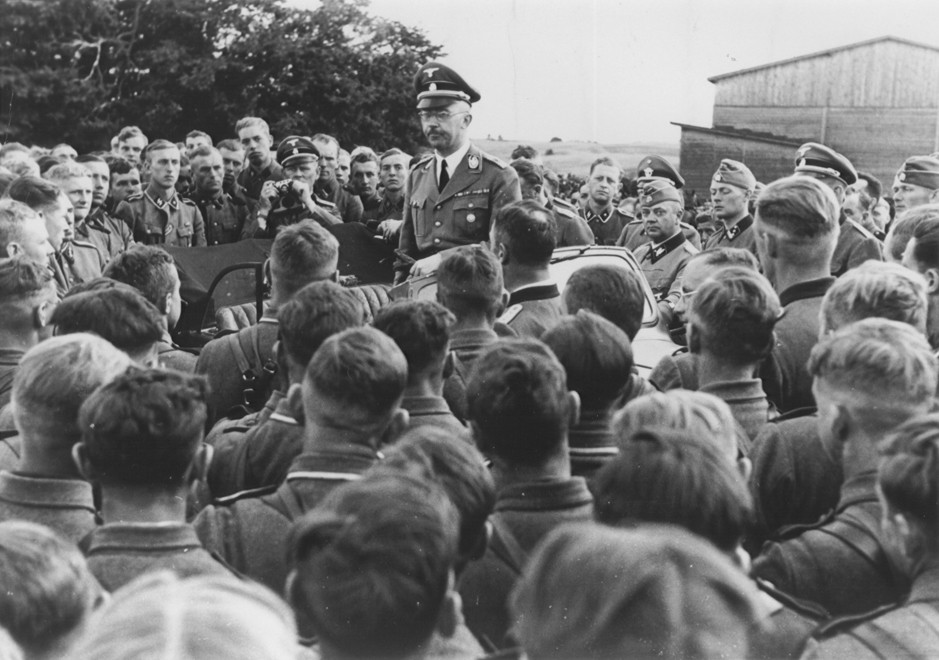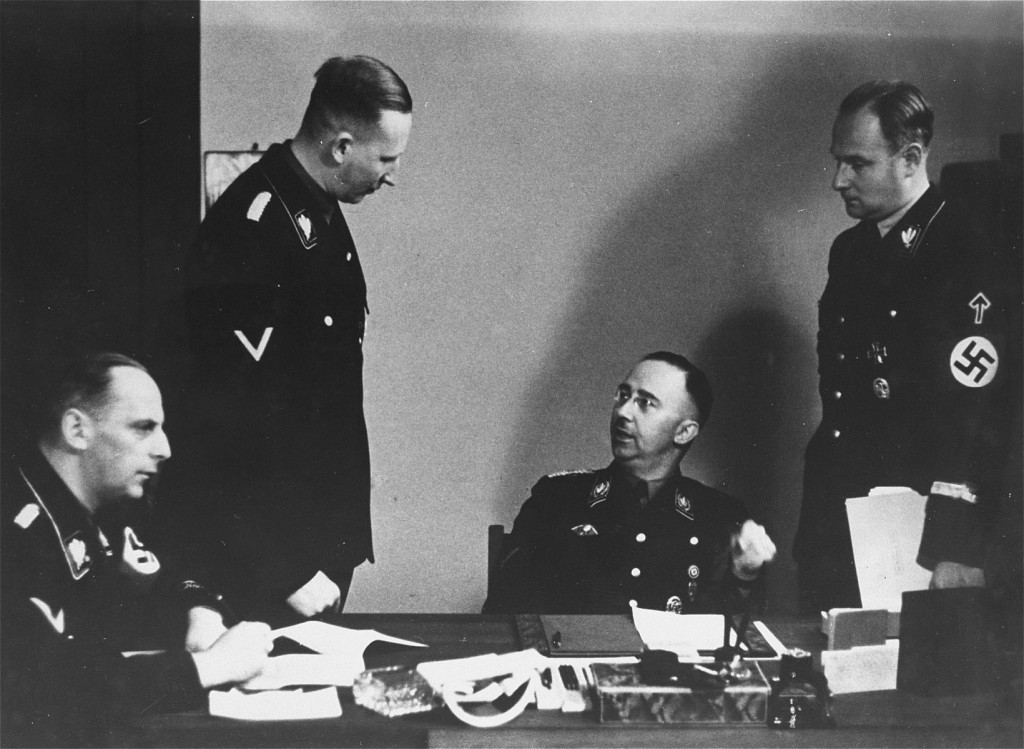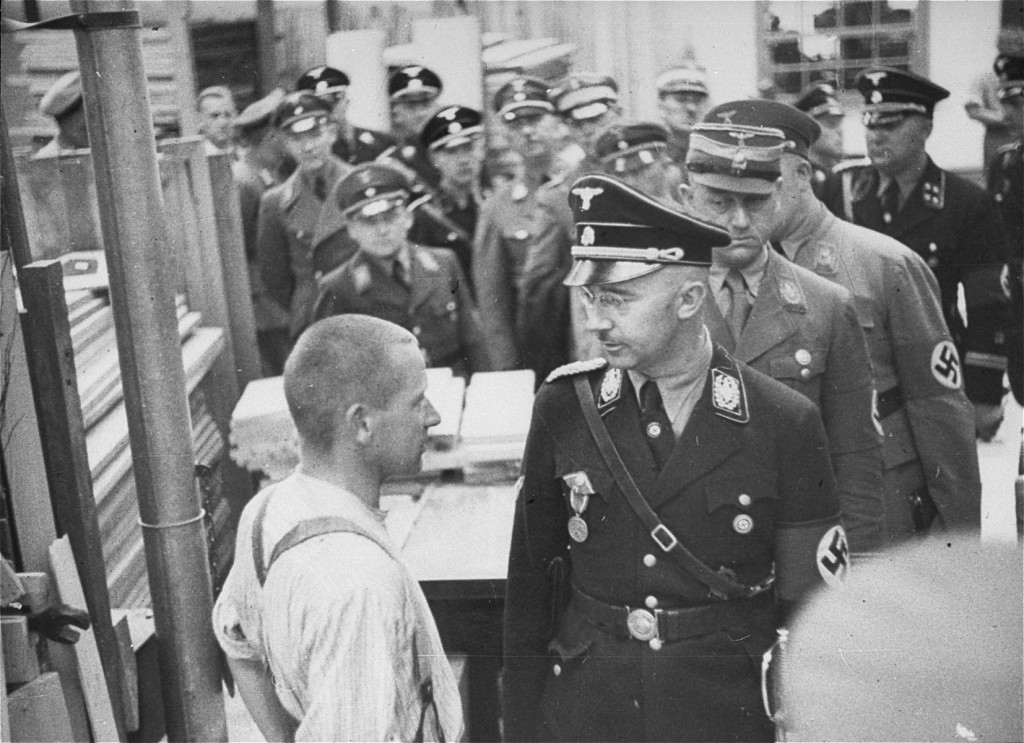
Heinrich Himmler
Overview
Heinrich Himmler (1900–1945) was the Reich Leader (Reichsführer) of the dreaded SS of the Nazi Party from 1929 until 1945. Himmler presided over a vast ideological and bureaucratic empire that defined him for many—both inside and outside the Third Reich—as the second most powerful man after Adolf Hitler in Germany during World War II. Given overall responsibility for the security of the Nazi empire, Himmler was the key and senior Nazi official responsible for conceiving and overseeing implementation of the "Final Solution," the Nazi plan to murder the Jews of Europe.
Background
Himmler was born into a middle-class, conservative Catholic family in Munich, Germany, on October 7, 1900. His father, Gebhard, taught at the Ludwig academic high school (Gymnasium) in Munich. In 1913, Himmler's family moved to Landshut, a town located about 40 miles northeast of Munich, after Himmler senior took the job of assistant principal of the Gymnasium in Landshut. As a youth, Himmler was fervently patriotic. During World War I, he dreamed of service on the front as an officer and, using his reluctant father's connections, left high school to begin training as an officer candidate on January 1, 1918. On November 11, 1918, however, before Himmler's training was complete, Germany signed the armistice that would end World War I.
Himmler graduated from high school in Landshut in July 1919. After the restrictions imposed on Germany by the Versailles peace treaty dashed his hopes of joining the army (Reichswehr), he studied agriculture at the Technical University in Munich. There he joined a German-nationalist student fraternity and began to read deeply in the racist-nationalist (völkisch) literature popular on the radical right of the interwar German political spectrum. By the time he received his university degree in August 1922, Himmler was a fanatical völkisch nationalist and a political activist.
Forced to take a job in a manure-processing factory in Schleissheim, near Munich, Himmler made contact with the National Socialists through SA chief of staff Ernst Röhm. In August 1923, he joined the Nazi Party, to which he devoted his career after he quit his job one month later. On November 9, 1923, Himmler marched with Hitler, Röhm, Hermann Göring, and other Nazi leaders in the Beer Hall Putsch against the German government.
Unemployed and at loose ends after the collapse of the putsch, Himmler found work as secretary and personal assistant to Gregor Strasser, whom Hitler appointed Reich Propaganda Leader of the Nazi Party in 1926. Himmler also built his own reputation in the party as a speaker and organizer. His speeches stressed the following themes:
- “race consciousness”
- cult of the German race
- the need for German expansion and settlements
- the struggle against eternal enemies of Germany. These "eternal enemies" were “Jewish” capital, “Marxism” (i.e., socialism, communism, and anarchism), liberal democracy, and the Slavic peoples.
In 1928 he married Margarete Boden. She bore him a daughter, Gudrun, in 1929.
Leadership of the SS
In January 1929, Adolf Hitler, the Führer (Leader) of the Nazi party, appointed Himmler Reichsführer SS. The SS, which in 1929 totaled 280 men, was subordinate to the SA and had two major functions: to serve as bodyguards for Hitler and other Nazi leaders and to hawk subscriptions for the Nazi party newspaper, Völkischer Beobachter (People's Observer). From this insignificant beginning, Himmler perceived an opportunity to develop an elite corps of the Nazi Party. By the time the Nazis seized power in January 1933, the SS numbered more than 52,000. Himmler also introduced two key functions to the SS that related to the Nazi party's long-term core goals for Germany: internal security and guardianship over racial purity.
After deploying his SS in April 1931 to crush a revolt by the Berlin SA against Hitler's leadership (inspiring the adoption of the SS motto, “My honor is loyalty”), Himmler created the Security Service (Sicherheitsdienst; SD) in the summer of 1931. The SD kept tabs on Hitler's opponents within the Nazi Party and gathered intelligence on leaders and activities of other political parties as well as on government officials, both federal and local. In August 1934, Nazi Party Deputy Führer Rudolf Hess announced that the SD would henceforth be the sole political intelligence gathering and evaluating agency in the Third Reich.
On the last day of 1931, Himmler also established a Race and Settlement Office (Rasse- und Siedlungsamt) of the SS to evaluate applications of SS men seeking to marry under a new internal “Marriage Decree.” The “expertise” developed in this role of maintaining “racial purity” in the SS would, in wartime, determine whether an individual was “German” or not. At a minimum, a positive determination meant a job and better rations in German-occupied territory during World War II; at a maximum, the decision on ethnicity could be a decision on life and death.
Control of the German Police
In the five years after the Nazis seized power in January 1933, Himmler built an unassailable position for the SS by taking control of the German police forces. On March 9, 1933, he was appointed provisional president of police in Munich. Three weeks later, he was named Commander of the Bavarian Political Police. By late 1934, Himmler sought and obtained command of each of the state political police departments in Germany, and had centralized them within a single new agency in Berlin, the Secret State Police (Geheime Staatspolizei; Gestapo).

After Hitler appointed him Reichsführer SS and Chief of German Police on June 17, 1936, Himmler centralized the various criminal police detective forces in Germany into the Reich Criminal Police Office (Reichskriminalpolizeiamt) and united the Gestapo and Criminal Police in the Security Police Main Office (Hauptamt Sicherheitspolizei). In September 1939, Himmler fused the Security Police and the SD into the Reich Security Main Office (Reichssicherheitshauptamt; RSHA), the agency that would be tasked with implementing the Holocaust in 1941–1942. Himmler also unified and centralized the uniformed police forces (Ordnungspolizei; Orpo) in Germany.
Centralization of the Concentration Camp System

In 1933–1934, Himmler also secured for his SS control over a centralized concentration camp system. Although various civilian authorities and police agencies had established autonomous concentration camps during 1933 to incarcerate political enemies of the Nazi government, Hitler—who was impressed with the Dachau concentration camp established by the SS in March 1933—authorized Himmler to create a centralized concentration camp system. Though this SS Inspectorate of Concentration Camps reduced the number of concentration camps to four in 1937, the system grew in wartime to include 30–40 main camps and hundreds of subcamps. SS camp authorities would kill around two million prisoners—Jews, political prisoners, Roma (Gypsies), so-called asocials, recidivist convicts, homosexuals, Jehovah's Witnesses, and others—in the concentration camp system.
Direct Authority from Hitler
As a reward for its role in murdering Ernst Röhm and the top leadership of the SA on June 30–July 2, 1934, Hitler announced that the SS was an independent organization and that Himmler was subordinate to Hitler in Hitler's new capacity as Führer of Germany. This position placed his authority outside the legal constraints of the German state. The command relationship between Hitler and Himmler was the basis for the immense power that Himmler accumulated during World War II. By tying the German police forces organizationally to the SS, Himmler effectively removed police personnel, finances, actions, and operations from external judicial or administrative review.
As Reichsführer SS, Himmler received authority directly from Hitler to carry out ideological policies that the laws of the state might not permit. This ideologically rooted “Führer authority” enabled authorization of indefinite incarceration and mass murder. The Nazi leaders justified this extra-legal chain of command and the policies initiated under its authorization by the national emergency legislation following the Reichstag Fire in 1933 and the intensified emergency created by the war.
Expansion of Himmler's Authority during World War II
Himmler expanded his authority during the war. On October 7, 1939, shortly after Germany conquered and partitioned Poland with the Soviet Union, Hitler appointed Himmler Reich Commissar for the Strengthening of German Ethnic Stock (Reichskommissar für die Festigung deutschen Volkstums; RKFDV). This position authorized Himmler and the SS to plan, initiate, and control the pace of German resettlement projects in occupied Poland, and, later, the Soviet Union. Organizations under Himmler's command had the final say over who was German, where ethnic Germans should live, and what populations should be moved out or annihilated in order to make room for the German settlers.
In July 1941, Hitler extended Himmler's authority for both security and settlement operations to the occupied Soviet Union. Himmler's exclusive responsibility for security behind the immediate front line authorized the mobile Einsatzgruppen and other SS and police units to initiate and direct the mass murder of Jews, Soviet officials, Roma (Gypsies), and people with disabilities living in institutions, with the support of German military and civilian occupation authorities. With Hitler's agreement, the SS, within its responsibilities for security and settlement issues, assumed the leadership role in planning and implementing the "Final Solution of the Jewish Question" as well as in annihilation operations throughout the Reich against Roma (Gypsies) and people with disabilities living in institutions.
In 1937, the SS had taken control of the Ethnic German Liaison Office (Volksdeutsche Mittelstelle), which ministered to the needs of ethnic Germans living outside the Reich. Among those needs were clothing and household equipment for newly resettled ethnic German communities. These items the SS supplied in part from the personal property taken from Jews murdered at the killing centers.
Perhaps in reflection of the growing power of the SS in the state, Hitler appointed Himmler Minister of the Interior in July 1943.
The SS and Germany's Armed Forces
In order to strengthen the position of the SS relative to the established German elites after a victorious war, Himmler persuaded Hitler in late 1939 to permit the establishment of an armed SS force, known as the Waffen SS. Although initially restricted to four divisions, the Waffen SS eventually fielded more than 20 Divisions, putting half a million men under arms and establishing a command and operations structure to rival the German army. That same year Himmler established a separate SS disciplinary system, since neither civilian nor military courts had jurisdiction to investigate criminal acts perpetrated by members of the SS and police or their auxiliary units.
As military defeats reduced the prestige of the generals in Hitler's view, Himmler's SS further encroached on the authority of the German armed forces. In February 1944, the Security Police and SD took over control of the Armed Forces Intelligence Service. After the failure of the military putsch of July 20, 1944, Hitler appointed Himmler Commander of the Replacement Army (a position responsible for training and overseeing military personnel) and gave him command of matters relating to prisoners of war. In December 1944, Himmler realized his old dream to have a command in the field, when Hitler appointed him commander-in-chief of Army Group Upper Rhine in southwestern Germany.
Challenges to Himmler's Power
Despite appearances to the outside, Himmler was not all-powerful in the Third Reich. His most significant and powerful rival during the last year of the war was Martin Bormann, Hitler's Secretary and chief of the Nazi Party Chancellery. The Nazi Party apparatus, anchored in the political power of the Nazi Party District Leaders (Gauleiter) who also held positions in the State as Regional Defense Commissars, became more significant with the invasion of the Allied armies toward the end of the war. Likewise, Albert Speer, the Reich Minister of Armaments and War Production, wielded great power in the last years of the war, despite his postwar protestations of powerlessness vis-à-vis the SS.
Murderous Success
A skilled organizer and a capable manager who understood how to obtain and use power, Himmler was the ideological and organizational driving force behind the rise of the SS. Moreover, he understood his SS men and knew how to secure their loyalty to his own person and to the concept of the Nazi elite to which they belonged. His ability to give his subordinates leeway to exercise initiative to implement Nazi policy was a significant factor in the murderous success of many SS operations.
When he took over the SS, Himmler recognized the importance of internal security and determination of racial purity for the Nazi movement and successfully expanded the functions of the SS to meet these ideological and practical needs. Himmler understood the importance of police power separated from legal constraint and state supervision; he persuaded Hitler—over the arguments of powerful rivals in the party and the state—that fusion of SS and police would forge the instrument for the Nazi regime to achieve its core, long-term ideological goals.
It was Himmler whom Hitler entrusted with the planning and implementation of the "Final Solution." In his most quoted speech, that of October 4, 1943, in Poznan to a gathering of SS generals, Himmler explicitly justified the mass murder of the European Jews in the following words:
In front of you here, I want to refer explicitly to a very serious matter….I mean here…the annihilation of the Jewish people…. Most of you will know what it means when 100 corpses lie side by side, or 500 or 1,000…. This page of glory in our history has never been written and will never be written….We had the moral right, we were obligated to our people to kill this people which wanted to kill us.
End of the War
After the failure of the July 20, 1944, attempt to assassinate Hitler, Himmler toyed with the idea of negotiating a separate peace with the western Allies while continuing to fight the Soviet Union. During the winter of 1944–1945, he considered using concentration camp prisoners as a bargaining chip to initiate such negotiations. In April 1945, Himmler met with the representative of the World Jewish Congress in Stockholm, Sweden, Hilel Storch, to discuss openings for negotiations. In part because the Allies would not negotiate with a man so implicated in Nazi crimes, and, in part because Himmler could not quite separate himself from Hitler or the belief that somehow the Germans would win the war, his half-hearted feelers came to nothing. In April 1945, Himmler asked Count Folke Bernadotte, the Vice President of the Swedish Red Cross, to transmit an offer of surrender on the western front to General Dwight D. Eisenhower, the commander-in-chief of the Allied forces. News of the offer reached Hitler in encircled Berlin on the night of April 28–29, 1945. In one of his last official acts, Hitler stripped Himmler of all of his offices and ordered his arrest.
Despite having continuously assured his SS officers and men that he ultimately would take responsibility for all of their actions, the end of the war found Himmler dressed in Secret Field Police uniform with papers in the name of Heinrich Hitzinger. Captured by Russian soldiers on May 20, 1945, he was turned over to the British, to whom he eventually confessed his identity. While undergoing a body search on May 23, 1945, Himmler killed himself by biting down on a cyanide capsule hidden in his mouth for that very purpose.
Critical Thinking Questions
Explore how challenges to ethical behavior and leadership played out in the context of the Holocaust. How do these challenges confront us today?
How and why did Himmler rise to prominence in the terror apparatus of Nazi Germany?
The Nazi regime required the active help or cooperation of professionals working in diverse fields who in many instances were not convinced Nazis. How did Himmler and other Nazi leaders use their positions of power to put their radical ideas into practice
How did the role of law enforcement change during 1933-1945? Why?
Can the changing role of law enforcement or other professions be a possible warning sign for mass atrocity?

